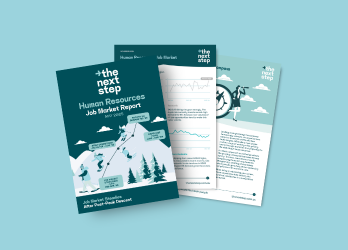Half-time in 2023: What’s impacting HR?
Half-time in 2023: What’s impacting HR?

As we enter the second half the year, Australia’s business landscape and the role of Human Resources (HR) is undergoing significant shifts. In this article we take a closer look at some of the prevailing trends that are shaping the People/HR function. These developments have far-reaching implications for organisations as they navigate the challenges and opportunities that lie ahead. Read on to learn more about the trends impacting HR in 2023.
Trends impacting HR in 2023
We have just ticked over into the 2nd half of the calendar year (and the start of the new FY), which is always an opportunity to take pause and review.
2023 started with a range of known, unknowns. In January we were asking: Where would interest rates land?; What impacts would rising inflation have on business and consumer confidence? and; Would unemployment jump significantly? These questions remain current.
In addition, we have seen new themes come to light, with some big-ticket items having distinct implications for People/Human Resources functions. Read on to learn more about the trends impacting HR in 2023.
Do more with less
As interest rates bite, consumers are starting to close their wallets. It’s become ‘crunch time’ for some consumer-driven sector margins, with input costs including wages rising. External cost pressures are requiring HR to support organisations with resourcing adjustments. Essentially the messaging is ‘do more with less’.
Even previously booming sectors, such as technology, are starting to consolidate. Tech sector Talent Acquisition teams are being slimmed-down. Even some of the tech heavyweights are focusing much more on performance.
For example, the Rear Window in the AFR hilariously reported that it was “mesmerised by news of Canva’s new performance ranking system.” In what looks like a relabelling of a circa 1990’s GE/Jack Welsh five tier performance ranking system Canva are ranking performance, from worst to best as: “Missing. Approaching. Thriving, Excelling and Redefining.” Given the cryptic nature of these labels, one can only imagine the cynical tech-types at Canva having a blast ribbing each other. Or, as the AFR said, “We welcome any reader attempt to explain that taxonomy”.
The other darling of the Australian IT sector, Atlassian, has also suddenly embraced a five-tier system (but retained the orthodox 1990’s labelling)… and still they pump their own tyres for being “the best place to work”.
Culture wars
Organisational culture has received a great deal of press attention recently, with a particular spotlight on partnerships and PwC. The extraordinary unravelling of the largest accounting firm in Australia has been compulsory viewing. Reports indicate that PwC is likely to end up smaller than it’s three main competitors Deloitte, EY and KPMG (who all have their own issues).
The Senate shows no sign of letting up, but when the dust does finally settle, it will be fascinating to see what the culture of ‘profit before ethics’ has cost the Big Four. Certainly, the financial damage and the cost to people’s careers has been extraordinary. It’s likely that shockwaves will extend to a broader assessment of the partnership model too. A lack of oversight of the Big Four and their consulting services has cost taxpayers billions of dollars. There are now calls for a Royal Commission.
Is this a cautionary tale that HR can leverage? Hopefully the PwC case-study can be used to influence business leaders across Australia, teaching them that ill-gotten short term gain can create long-term pain. Or, put more simply… just do the right thing.
AI and productivity
Many organisations expect the HR profession to sit at the forefront of productivity improvements and operating model changes due to AI. That said, AHRI reported in July, that most HR professionals are approaching the use of AI technology with trepidation.
These findings are supported by a Gartner survey which revealed that just five per cent of HR leaders had already implemented generative AI with another nine per cent looking at pilots. Notwithstanding this small initial take up, they made the point that HR expects to take a leading role in the evolution of generative AI. Underscoring this, the majority of respondents saw AI as an unavoidable part of HR’s future and were participating in enterprise-wide discussions around their organisations overall take up.
The banking sector is an early adopter, driving AI uptake and innovation. ANZ has long been ahead of the pack when it comes to offshoring jobs and is now further increasing it’s investment in India. National Australia Bank (NAB) and CBA are following suit, with plans to dramatically increase the size of their own Indian operations.
The banks are hiring highly-skilled engineers, architects and business analysts. They are particularly keen to tap Indian expertise in emerging areas like artificial intelligence. The NAB’s Chief Technology Officer, Patrick Wright said proudly, “We have tap into global capabilities to find the skills we need.”
The reality is that where the banks lead, other sectors will soon follow. HR will be required to manage transformations and must be ready for the change.
Executive reward, boards and public perceptions
It seems that boards are becoming sensitive to public and shareholders. They are asking: How much is enough?
Despite average realised pay for ASX 100 CEOs falling to the lowest level recorded in nine years, executive reward could become a lightning rod of discontent, given current cost-of-living pressures. After all, CEO salaries remain a very healthy $5.3 million per annum (compared with $5.7 million in the 2017). Surely they are not crying poor are they?
This year’s list of best paid CEO’s was led by Resmed boss Mick Farrell, who took home realised pay of $47.1 million in 2022, just ahead of Goodman Group’s Greg Goodman ($44.3 million, who is always up there and goodness knows what he does with it all) and News Corporation boss Robert Thomson ($35.2 million).
As mentioned previously, PWC, Deloitte, KPMG and EY are already in the pay spotlight. When speaking to the Senate Deloitte CEO, Adam Powick, couldn’t defend his pay packet which is seven times more than the Prime Minister (not including the trailing long term pensions retiring partners achieve every year).
Look at any ASX listed companies annual report and its clear Executive Reward and Compensation Strategy is high profile. For instance, the Remuneration Report in the NAB’s current Annual Report runs to 34 pages long – all pretty tables, graphs and pie charts. It’s obviously a big deal for companies to explain the quantum’s offered to C Suites.
With the mid-season earnings reporting season just starting and the potential for some notable profit downgrades resulting in unhappy shareholders, executive compensation will remain as high profile as any time in the past. Remuneration is always a peak responsibility for HR and yet time and again, this crucial function is very often under resourced by CPO’s and over pressured by the business. This is constant feedback from Remuneration professionals.
Pay remediations
The list of organisations to self-report underpayment of employee’s minimum pay rates and entitlements is starting to get very long.
On top of this, in 2022 alone, the Fair Work Ombudsman performed over 4,000 investigations in Australia. These reviews resulted in the recovery of approximately $532 million of unpaid wages and entitlements, of which $279 million related to 267,000 employees of large corporates. Media initially focused on large retailers and hospitality but now the issue of wage underpayment appears to impact businesses of all sizes and sectors of the economy. The latest to take centre stage is the tertiary sector. Are there still some Uni’s to fess up?
Most firms that have self-reported are large and have sophisticated systems which can be used to untangle underpayment. However, there are many, many organisations that have antiquated systems at best. Goodness knows how they will ever get to the bottom of the issue. HR and payroll teams are no doubt busy in the background!
Workplace cadence and place
When it comes to hybrid ways of working, the HR community is performing a delicate balancing act between delivering what executive teams and employees want. Even within the same sectors, there are differences in approach.
CBA was amongst a wide range of organisations to publicly mandate office attendance. They haven’t even begun to implement the mandate yet, but already the FSU has challenged the decision with the Fair Work Commission. CBA is insisting that more than 20,000 non-customer-facing staff spend at least 50 per cent of their time in the office each month.
On the flipside, NAB have a draft EBA that enshrines work-from-home conditions which could set a precedent for the wider financial services sector. (You can almost hear a collective groan from the property sector).
HR job market… time to manage expectations
Current interest rate hikes would suggest a downturn in CBD housing prices. That hasn’t happened. Why? For a start, owners are nervous about listing property in the current market, resulting in a third less stock on the market than normal. As such, demand continues to outstrip supply.
Just like the property market, unless really required, candidates aren’t emboldened to take a brave career decision and change jobs when the economy is looking shaky. Instead, they are hunkering down and staying put… unless temped by a compelling offer.
On the flip side, hiring managers think because it’s a slightly softer market, they will have their choice of HR professionals. Some even believe they might even get a bargain. They’ll have to think again. Our latest HR Job Index shows that Human Resources professionals are still in strong demand in the 2nd half of 2023.
Meanwhile at the big end of town in the plus $1 million market, some moves include; Qantas are in the market for hire their new CPO; Susan Ferrier has retired from her $1.3 mil CPO role at NAB; and Deborah Eckersley has recently finished as People & Culture at Bank of Queensland. More to follow we suspect. Some are wondering how substantial the rumours are, of a search in progress for Westpac?
How can we help?
The landscape for Human Resources (HR) continues to evolve, shaped by a myriad of factors impacting organisations and their workforces.
If you are looking for more details on how and where we’re seeing these trends play out, or you would like a more detailed update on the evolving HR job market, please get in touch with Craig or any of The Next Step team.



